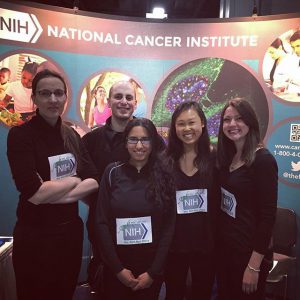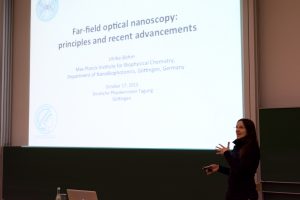Science can only go so far without the support of the public. One effective method of engaging with the public and gaining their support, as well as ensuring a steady supply of talented future scientists, is through active science communication. This page provides an overview of some of my science communication activities:
Outreach events
 Over the last couple of years since 2005, I have used multiple opportunities to communicate science, physics, and microscopy to the public, e.g.
Over the last couple of years since 2005, I have used multiple opportunities to communicate science, physics, and microscopy to the public, e.g.
- as a participant in career events at my local high school to talk about what it is like to be a woman in physics and to work in science,
- as a tour guide during open house events at the physics department at the Technical University of Munich as well as at the Max Planck Institute for Biophysical Chemistry in Goettingen,
- as science slam host in Goettingen and Berlin during different conferences,
- as co-organizer of science outreach events of the National Institutes of Health | National Cancer Institute at the USA Science and Engineering Festival in Washington, D.C.,
- as journal club host for high school and college students in Bethesda, MA, and most recently
- as Janelia Science Ambassador at the Janelia Research Campus in Ashburn, VA to engage with the public during after scientific talks at Janelia to answer open questions about the events, Janelia and its scientific focus.
During all these events, I can not only inform people about science, physics, and microscopy, but they also allow me to share my passion. 🙂
Public lectures
 Furthermore, I am always happy to give public lectures to high school students, college, and university students about science, physics, and microscopy.
Furthermore, I am always happy to give public lectures to high school students, college, and university students about science, physics, and microscopy.
Two of my favorite public lectures were the following ones:
- During the “19. Deutsche Physikerinnen Tagung” (a conference for women in physics in Germany organized by the German Physical Society) in Goettingen during the “International Year of Light”, I was invited to give one of the keynote lectures about “Far-field optical nanoscopy: principles and recent advancements.” It was a very special lecture because my Ph.D. advisor had just won the Nobel Prize “for the development of super-resolved fluorescence microscopy,” and the lecture hall was packed. The audience was very keen to learn more about the bells and whistles of microscopy, and it was super fun to share some anecdotes.
- In the same year, I was also invited to give a lecture about “Super-Resolution Fluorescence Microscopy: Overview and Stimulated Emission Depletion (STED) Microscopy” to Spanish high school students and undergraduate college and university students during an International Science Camp at the XLAB. The XLAB is an experimental laboratory for young people in Goettingen (incorporated society). Its aim is to bridge the gap between scientific research and school teaching. It was a fun lecture because I used for the first time optics experiment while I was explaining the core principles for microscopy, superresolution microscopy, and fluorescence during my lecture. I can also still vividly remember how I was transporting my experimental equipment by bike to the XLAB.
For further information or if you have any questions, please do not hesitate to contact me.